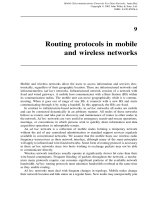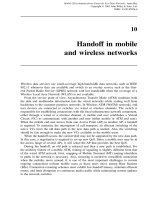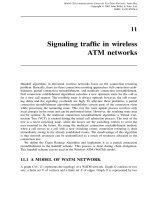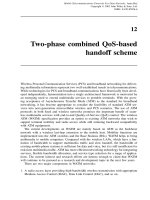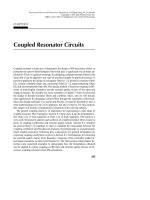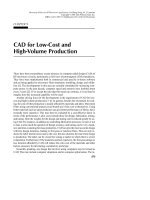Tài liệu DAV Nguyên tắc và các ứng dụng P11 ppt
Bạn đang xem bản rút gọn của tài liệu. Xem và tải ngay bản đầy đủ của tài liệu tại đây (132.58 KB, 15 trang )
11
Signaling traffic in wireless
ATM networks
Handoff algorithms in terrestrial wireless networks focus on the connection rerouting
problem. Basically, there are three connection rerouting approaches: full connection estab-
lishment, partial connection reestablishment, and multicast connection reestablishment.
Full connection establishment algorithms calculate a new optimum route for the call as
for a new call request. The resulting route is always optimal; however, the call rerout-
ing delay and the signaling overheads are high. To alleviate these problems, a partial
connection reestablishment algorithm reestablishes certain parts of the connection route
while preserving the remaining route. This way the route update process involves only
local changes in the route and can be performed faster. However, the resulting route may
not be optimal. In the multicast connection reestablishment algorithm, a Virtual Con-
nection Tree (VCT) is created during the initial call admission process. The root of the
tree is a fixed switching node, while the leaves are the switching centers to serve the
user terminal in the future. By using the multicast connection reestablishment method,
when a call moves to a cell with a new switching center, connection rerouting is done
immediately owing to the already established routes. The disadvantage of this algorithm
is that network resources can be underutilized as a result of resources allocated in the
connection tree.
We define the Chain Routing Algorithm and implement it as a partial connection
reestablishment in the handoff scheme. This process is done during chain elongation.
This handoff scheme can be used in the Wireless ATM (WATM) model.
11.1 A MODEL OF WATM NETWORK
AgraphG(V , E) represents the topology of a WATM network. Graph G consists of two
sets: a finite set V of vertices and a finite set E of edges. Graph G is represented by two
Mobile Telecommunications Protocols For Data Networks. Anna Ha
´
c
Copyright
2003 John Wiley & Sons, Ltd.
ISBN: 0-470-85056-6
198
SIGNALING TRAFFIC IN WIRELESS ATM NETWORKS
subgraphs: G
1
that represents a set of ATM switching centers, and G
2
that represents a
set of Base Stations (BSs). The network model is defined as follows:
• The topology of the higher level of wired subnetwork is represented by an undirected
subgraph G
1
= (V
1
,E
1
), where each edge e ∈ E
1
represents the number of commu-
nication channels and each node in V
1
represents an ATM switching center. G
1
⊂ G,
V
1
⊂ V ,andE
1
⊂ E.
• Each edge e
i
in G
1
has a limited capacity to carry a number of calls; each of these calls
occupies one unit. The edges between ATM switching centers represent communication
channels. The number of links is the same in each channel. The capacity of each edge
is defined as C
1
(e
i
).
• The subtopology of the BSs and their related ATM switching centers are represented by
an undirected subgraph G
2
= (V
2
,E
2
), where each edge e ∈ E
2
represents the number
of channels between a base station and a switching center that are directly connected,
and each node in V
2
represents a base station connected to the ATM switching center.
G
2
⊂ G, V
2
⊂ V ,andE
2
⊂ E.
• Each edge e
i
in G
2
has a limited capacity to carry a number of calls; each of these
calls occupies one unit. The edges between BSs and their ATM switching centers also
represent channels. The number of links in each channel is the same. The capacity of
each edge is defined as C
2
(e
i
).
• Two different BSs can establish a channel connection by allocating one edge or a
sequence of edges, possibly across several ATM switching centers.
• A communication call request is denoted by r
i
= (s
1
,s
2
,d
1
,d
2
,h
1
,h
2
). This call request
consists of six elements: s
1
and s
2
are the source ATM switching center and the source
BS, respectively; d
1
and d
2
are the destination switching center and the destination
BS, respectively; and h
1
and h
2
are the handoff switching center and the handoff BS,
respectively.
• When a call request is a general call without handoff, the call request is denoted by
r
i
= (s
1
,s
2
,d
1
,d
2
) and the handoff request options are h
1
= 0, and h
2
= 0. When a
call request is a handoff request, the handoff request options are h
1
= 0andh
2
= 0.
• For each edge e
i
, which is between the ATM switching center and the BS, the total
number of channels allocated for a set of call requests R
2
(r
1
,r
2
,...,r
n
) that arrived in
the BS cannot exceed the capacity of the edge between the ATM switching center and
the BS. That is, R
2
(r
i
) ≤ C
2
(e
i
) for all i,1≤ i ≤ number of links in a base station.
• For each edge e
i
, which is among switching centers, the total number of channels
allocated for a set of call requests R
1
(r
1
,r
2
,...,r
n
) that arrived in the switching center
from the BS cannot exceed the capacity of the edge between ATM switching centers.
That is, R
1
(r
i
) ≤= C
1
(e
i
) for all i,1≤ i ≤ number of links between a switching
center and its BSs.
• Let Idle r
1
(e
i
) denote the available number of channels e
i
among switching centers and
Idle r
2
(e
i
) denote the available number of channels e
i
between switching centers and
its BSs. A call request r
i
= (s
1
,s
2
,d
1
,d
2
) will be rejected if (Idle r
1
(e
i
)<R
1
(r
i
)) ∪
(Idle r
2
(e
i
)<R
2
(r
i
)).
• Any mobile host can access the network directly via a radio link to a base station that
is virtually connected.
CHAIN ROUTING ALGORITHM
199
11.2 CHAIN ROUTING ALGORITHM
Handoff procedures involve a set of protocols to notify all the related entities of a par-
ticular connection for which a handoff has been executed, and the connection has to be
redefined. During the process, conventional signaling and additional signaling for mobil-
ity requirements are needed. The mobile user is usually registered with a particular point
of attachment. In the voice networks, an idle mobile user selects a base station that is
serving the cell in which it is located. This is for the purpose of routing incoming data
packets or voice calls. When the mobile user moves and executes a handoff from one
point of attachment to another, the old serving point of attachment has to be informed
about the change. This is called dissociation. The mobile user will also have to reassociate
itself with the new point of access to the fixed network. Other network entities involve
routing data packets to the mobile user and switching voice calls that have to be aware
of the handoff in order to seamlessly continue the ongoing connection or call. Depending
on whether a new connection is created before breaking the old connection, handoffs are
classified into hard and seamless handoffs.
The Chaining scheme extends the connection route from the previous BS to the new
BS by provisioning some bandwidth using Virtual Channel (VC) or Virtual Path (VP)
reservations between neighboring BSs. Chaining can simplify the protocols and reduce
signaling traffic significantly and it can be accomplished quickly. However, chaining will
typically degrade the end-to-end performance of the connection and the connection route
is no longer the most efficient. This could lead to dropped calls if resources in the WATM
are not available for chaining. To improve the route efficiently and reduce the number of
dropped calls, we propose the Chain Routing Algorithm.
We consider a broadband cellular network based on a hierarchical ATM network.
In the planar environment, each cell is hexagonal, as shown in Figure 11.1. The BS
of each cell has some Permanent Virtual Circuits (PVCs) connected to the other BSs in
neighboring cells. Also, each BS has a number of PVCs connected to the ATM switch
ABC
D
ATM switch
1
2
3
4
Figure 11.1 Planar personal communication network.
200
SIGNALING TRAFFIC IN WIRELESS ATM NETWORKS
only for the use of handoff calls. A parameter describing Occupancy Rate of the PVC
(ORP) is proposed for each BS. Overall, ORP is the larger number of occupancy rate of
PVCs between the BS and its neighboring BS and the occupancy rate of PVCs between
the BS and the ATM switch.
When a mobile makes a new call, its BS will establish a Switched Virtual Circuit
(SVC) to carry the new call. When the terminal user moves to an adjacent cell, the traffic
path will be extended by a PVC from the current cell to the adjacent cell. The chain
length will be elongated by 1. Whenever the chain is elongated, one bit will be sent back
to check the ORP of all the BSs on the chain route.
When the elongation is set up and all the BSs on this route have low occupancy rate,
the network will follow the PVC-based scheme. In this scheme, if a user roams from its
current cell to a new cell, the traffic path is elongated by the PVCs between these two
cells. The traffic path will keep growing if the user keeps roaming. However, maintaining
connections by continuously elongating paths from original cells to the new cells will
cause the path to be inefficient.
When some parts of the route have a high occupancy rate, we propose two ways to
reroute the chain parts of the route:
From the last station on the chain after each elongation, we propose sending one bit
back through the chain and checking the ORP of each BS on the chain.
The path will be rerouted according to one of the following two schemes:
1. Select a route in which the length of the path is the shortest. If length of the route is
shorter, it is more likely to be selected.
2. Select the path in which the PVCs have lower occupancy rate. That is, a PVC between
an ATM switch and any BS in the elongation route can be set up in order to obtain
a low ORP. The number of options that are available is N,whereN is equal to the
length of the chain.
The chain has to be rerouted whenever there is a better chain route, and the speed of
elongation will be slowed down. The network efficiency can be improved significantly.
The path can be rerouted following the first scheme.
From the last station on the chain after each elongation, we send one bit back through
the chain and check the ORP of each BS on the chain. If the resultant ORP of a base
station is close to jam, we stop, move back one BS, and use this BS’s PVC to connect to
the ATM switch. If the BS at the end of the chain has a very high ORP or it is jammed,
we have to send a signal to the connection server to reroute the call.
If the speed of elongation is high, the signaling and calculation cost is reduced, and
the network efficiency is lower than in the Chain Routing.
We illustrate how the Chain Routing Algorithm operates by using an example. Referring
to Figure 11.1, let the BS in Cell 1 be denoted as BS
1
. When a mobile initiates a new call
in Cell 1, BS
1
will establish an SVC between itself and the ATM switch. We consider
that the mobile roams to its neighboring Cell 2 and the traffic path is elongated by the
PVCs between these two cells. One bit is sent back through the chain and we check the
ORP of each BS on the chain. Suppose both the BSs have low ORPs, then no rerouting
occurs. We consider that the mobile roams to its neighboring Cell 3 and the traffic path
CHAIN ROUTING ALGORITHM
201
is elongated by the PVCs between these two cells. One bit is sent back through the chain
and the ORP of each BS on the chain is checked. Suppose both the BSs have low ORPs,
then no rerouting occurs. Consider that the mobile roams to its neighboring Cell 4 and
the traffic path is elongated by the PVCs between these two cells. One bit is sent back
through the chain and the ORP of each BS on the chain is checked.
We have four route options:
1. Cell 4 – Link D – ATM switch
2. Cell4–Cell3–LinkC–ATMswitch
3. Cell4–Cell3–Cell2–LinkB–ATMswitch
4. Cell4–Cell3–Cell2–Cell1–LinkA–ATMswitch.
Suppose the BS of Cell 3 has a high ORP, then a new route 1 will be set up.
If part of the chain route is within one ATM switch, this chain route can be easily
implemented. If the chaining route is across more than one ATM switch, this chain route
method cannot be applied to the other ATM switches, because more than one ATM
switch is involved, and the reroute cannot be done locally. A signal has to be sent to the
connection server to reroute the call.
We illustrate how to solve this problem by using Figure 11.2.
We make a PVC neighbor link between BSs within one ATM switch and a different
neighbor link connecting two BSs from two ATM switches. The neighbor link connecting
two BSs from two ATM switches is a Cross ATM Switch Link (CASL). The CASL in
Figure 11.2 is the link between Cell 3 and Cell 4.
The chain route has information about where it crossed more than one ATM switch.
The Chain Routing Algorithm applies to the ATM area in which the chain started. When
A
1
2
3
4
5
6
BC
ATM switch ATM switch
Figure 11.2 Move with more than one ATM switch involved.
202
SIGNALING TRAFFIC IN WIRELESS ATM NETWORKS
the sent-back bit detects that it has arrived at the ATM switch in which the chain started,
it will begin applying the Chain Routing Algorithm.
Suppose the mobile roams into Cell 6 and one bit is sent back through the chain route.
When the sent-back bit sees the CASL, the Chain Routing Algorithm will be used.
In this case, we have three route options:
1. Cell6–Cell5–Cell4–Cell3–LinkC–ATMswitch.
2. Cell6–Cell5–Cell4–Cell3–Cell2–LinkB–ATMswitch
3. Cell6–Cell5–Cell4–Cell3–Cell2–Cell1–LinkA–ATMswitch.
If the BS of Cell 2 has a high ORP, for example, a new route 1 will be set up.
11.3 IMPLEMENTATION OF THE HANDOFF SCHEME
The Chain Routing Algorithm has to be implemented in the handoff scheme. The Chain
Routing Algorithm is added to the handoff scheme (chaining followed by make-break) in
Step 5 as follows:
1. The mobile host sends a handoff request message to the new BS identifying the old
BS and its connection server.
2. The new BS adds local translation table entries for its internal routing.
3. The new BS asks the old BS to forward packets pertaining to the mobile host.
4. The new BS sends back a handoff response message to the mobile host, instructing
the mobile host to transmit/receive through the new station.
5. We include the Chain Routing Algorithm. A single bit is transferred from the mobile
host back to the starting point of the chain route. It checks the ORP of each BS.
After the new route is found and the new BS chosen, which is connected to the ATM
switch, the new BS sends a message to the ATM switch channel server (performing
make, break, and break-make). The new BS can change its translation table entries
in its BS channel server immediately and the new connection between the chain
to the ATM switch is established. This way, the chaining portion of the handoff is
completed. Note that these five steps 1, 2, 3, 4, and 5 are accomplished in real time.
6. The new BS passes the updated route information to the connection server.
7. The connection server performs necessary Quality-of-Service (QoS) computations on
the new route. Note that the connection server has centralized knowledge of a signif-
icant portion of the route and can perform this calculation easily. If the connection
server detects a possible QoS guarantee violation, or if the fixed links are becom-
ing congested and route efficiency is desired, the connection server undertakes the
following steps: 8, 9, and 10.
In all other cases, the handoff flow terminates at this point.
8. This is the first step of the make-break portion of the handoff. The connection server
identifies the best route to the Crossover Switch (COS), allocates resources along the
new route, and sets up a new routing entry in the COS. The switch multicasts cells
received from the source to both BSs.



